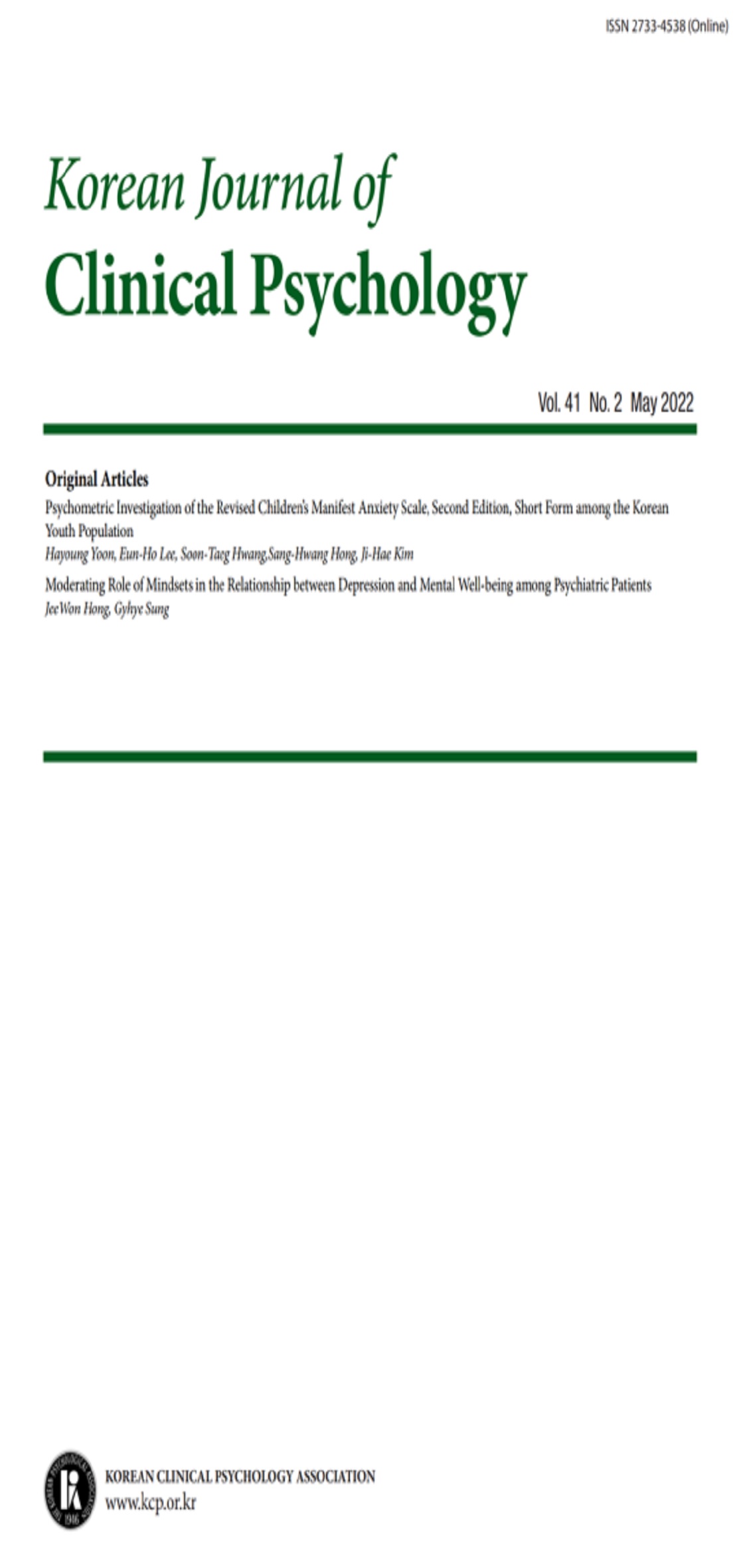open access
메뉴
open access
메뉴 E-ISSN : 2733-4538
E-ISSN : 2733-4538
본 연구는 우울장애와 불안장애 청소년의 부정적 자기도식을 변화시키고 대인관계에서 요구되는 사회적 기술의 습득을 목표로 하는 집단 인지행동치료 프로그램의 효과에 관한 예비연구로서 치료 프로그램을 제작 후 시행하여 효과를 검증하고 6개월 후 추후조사에서도 그 효과가 유지되는지를 비교하였다. 지역사회에서 설문조사를 통해 높은 우울증상과 불안증상을 보고한 중학생 279명을 선별한 후 진단적 면접에서 우울장애와 불안장애로 진단된 중학생 8명(남자 2명, 여자 6명)을 대상으로 2시간씩 1주에 2회, 총 6회기의 집단 인지행동치료 프로그램을 실시하였다. 치료 후 청소년의 우울증상과 불안증상이 유의하게 감소되었으며 사회불안 영역에서 수행과 관련한 불안과 부정적 평가 두려움이 유의하게 감소되었다. 자기개념도 긍정적으로 변화하였고 부정적 또래 표상도 감소되었다. 부정적 사고 영역에서 우울 인지, 사회불안 인지, 신체적 위협인지가 감소되었다. 집단 인지행동치료의 효과는 6개월 후 추후평가에서도 유지되어 우울증상은 물론 사회불안 영역의 수행불안, 부정적 평가에 대한 두려움의 감소가 유지되었고 자기개념도 긍정적으로 유지되었다. 이와 같은 결과에 대해 치료효과 영역별로 논의하였고 청소년기 우울장애와 불안장애 치료에 대한 임상적 시사점과 연구의 제한점 그리고 후속연구에 대해 제언하였다.
This preliminary study aimed to develop a group Cognitive Behavioral Therapy(CBT) program for the adolescents with depression and anxiety disorders. The CBT program intended to alter the negative self- scheme and to train the social skills of the adolescents, which is required in the interpersonal relationships. Through a screening survey, 279 junior high school students with high scores in depression and anxiety was selected and then eight students(2 male, 6 female) among them was selected through detailed diagnostic interview. The CBT program was conducted to 8 students: two 2-hour-sessions per week, for three weeks. The subjects showed significantly lower scores in depression and anxiety after the treatment, and they also showed significantly lower level of social anxiety, especially in the subcategories of the performance anxiety and of the fear of negative feedback. And the subjects reported positive change of self concept, and the level of their depressive cognition, social anxiety cognition, and negative peer representation were decreased. The effects in depressive symptoms, performance anxiety, fear of negative feedback, and positive self-concept maintained at six months follow up. Lastly we discussed the results by subcategories and the clinical implications for the adolescents' depression and anxiety. Limitations and suggestions for future study were mentioned.
(1997) 정신건강 증진을 위한 접근책,
(2002) 한국판 아동청소년용 자동적 사고척도(K-CATS)의 타당화 연구,
(2002) 한국판 아동 청소년용 사회불안 척도의 타당화 연구,
(2000) 청소년기를 밝고 건강하게-중학교 인성교육 프로그램, 교육과학사
(1997) 지역사회거주 청소년의 우울증상 유병율,
(1991) 한국에서의 the Center for Epidemiological Studies-Depression Scale 의 사용-표준화 및 요인구조에 대한 횡문화적 검토-,
(2001) K-YSR 청소년 자기행동평가척도, 중앙적성출판사
(1990) 소아 불안의 측정-RCMAS의 신뢰도와 타당도 검사,
(1991band1991profiles) Manual for the Youth Self-Report University of Vermont,
(2001) Cognition in childhood anxiety: conceptual, methodological and developmental issues,
(1979) Cognitive therapy of depression, Guilford Press
(1997) A Clinical Psychotherapy trial for adolescent depression comparing cognitive, family, and supportive therapy,
(1990) Instructor's manual for the adolescent coping with depression course Kaiser Permanente Center For Health Research,
(1998) Cognitive-behavioral group treatment of adolescent depression: Replication of acute treatment efficacy, and effects of maintenance therapy,
(1995) Targeted prevention of unipolar depressive disorder in an at-risk sample of high school adolescents A randomized trial of a group cognitive intervention Journal of the American Academy of Child and Adolescent Psychiatry,
(1988) Statistical power analysis for the behavioral science, Academic Press
(2001) Specific psychotherapies for Childhood and Adolescent Depression,
(1995) Family therapy for the treatment of depressed adolescents,
(2000) Prevention of childhood anxiety disorders,
(1997) The effects of unemployment on psychiatric illness during young adulthood,
(1988) The interactive influence on adolescent and maternal depression on adolescent social and cognitive functioning,
(2002) School-Based for Anxious African-American Adolescents,
(1988) Manual for the Self Perception Profile for Adolescents University of Denver,
(1998) The relationship between peer status and depressive symptoms in children and adolescents,
(1991) A Statistical Approach to Defining Meaningful Change in Psychotherapy Research Journal of Consulting and Clinical Psychology,
(1990196-211) Comparison of cognitive-behavioral and self-modeling interventions for depression among middle-school students,
(1997) Schedule for Affective Disorders and Schizophrenia for School-Age Children-Present and Lifetime Version,
(2004) The Reliability and Validity of Kiddie-Schedule for Affective Disorders and Schizophrenia- Present and Lifetime Version-Korean Version ,
(1984) The coping with depression course A psychoeducational intervention for unipolar depression, Castalia Publishing
(1999) Psychosocial treatments for adolescent depression,
(1990) Cognitive-behavioral treatment for depressed adolescents,
(1998) Major depressive disorder in older adolescents: Prevalence, risk factors and clinical implications,
(2002) A longitudinal Study of Children's Depressive Symptoms Self-Perceptions and Cognitive Distortions About the Self ,
(2002) How effective are treatments for child and adolescent depression?: A meta-analytic review,
(1996) Interpersonal psychotherapy for depressed adolescents: A one-year follow-up study,
(1988) Impact of adolescent drug use and social support of problems of young adults Journal of Abnormal Psychology,
(1997) Retrospective recall of family factors on social phobia and panic disorder,
(1978) What I think and feel-A revised measure of Children's Manifest Anxiety Journal of Abnormal Child Psychology,
(1994) Depression vulnerability in children The role of cognitive-interpersonal variables University of California, Unpublished doctorial dissertation
(1992) Development and validations of measures of maternal and self representations in school-aged children,
(2001) Development and validation of a measure children's automatic thoughts: the Children's Automatic Thoughts Scale, Manuscript submitted for publication
(1996) Treatment for children and adolescents with depression,
